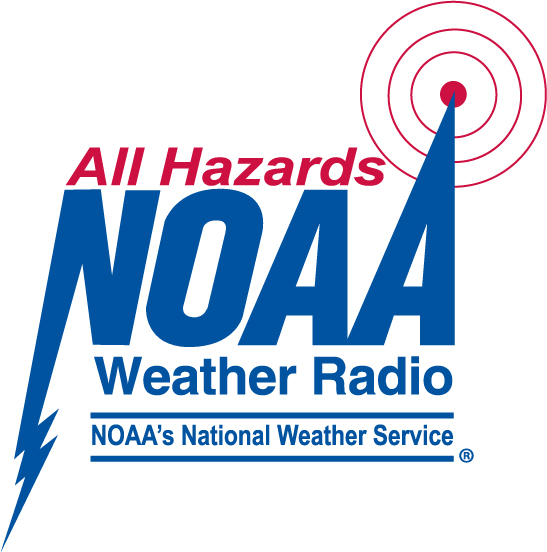NOAA Weather Radio All-Hazards (original) (raw)
About NOAA Weather Radio:

NOAA Weather Radio All-Hazards (NWR) is a nationwide network of radio stations broadcasting continuous weather information directly from a nearby National Weather Service forecast office. NWR broadcasts National Weather Service watches, warnings, forecasts and other hazard information 24 hours a day.
Known as the "Voice of the National Weather Service," NWR is provided as a public service by the Department of Commerce's National Oceanic and Atmospheric Administration, and covers the 50 states, District of Columbia, Puerto Rico, U.S. Virgin Islands, and U.S. Pacific Territories. There are over 1000 NWR transmitters in operation, covering approximately 97% of the U.S. population.
NOAA Weather Radio All-Hazards broadcasts emergency and post-event information for all types of hazards -- both natural (such as severe weather, flooding, earthquakes and volcanic activity) and man-made (such as chemical releases or oil spills). Working with other Federal agencies and compatible with the Federal Communication Commission's Emergency Alert System (EAS), NWR is an "all hazards" radio network, making it the single source for the most comprehensive weather and emergency information available to the public.
The National Weather Service office in Lincoln operates 9 NOAA Weather Radio transmitters. Click on the location for coverage areas and county codes for use in your NWR receiver.
| Location | Transmitter | Transmitter Location | Cities Covered |
|---|---|---|---|
| Bloomington | KZZ-65 (162.525 MHz) | Far west side of Bloomington | Bloomington/Normal, Clinton, Mackinaw, and Eureka |
| Champaign | WXJ-76 (162.550 MHz) | WCIA-TV tower near Seymour | Champaign-Urbana, Charleston-Mattoon, Danville, Paxton, Paris, and Farmer City |
| Galesburg | KZZ-66 (162.400 MHz) | 2 miles northeast of Galesburg | Galesburg, Kewanee, and Monmouth |
| Jacksonville | WXM-90 (162.525 MHz) | 2 miles south of Lynnville | Jacksonville, Beardstown, Winchester, Mount Sterling, Pittsfield, and Carrollton |
| Newton | KXI-48 (162.450 MHz) | 6 miles south of Newton | Effingham, Greenup, Marshall, Newton, Robinson, Olney, Flora, Lawrenceville, Fairfield, and Albion |
| Paris | KXI-47 (162.525 MHz) | 2 miles south of Paris | Charleston, Tuscola, Paris, and Marshall in Illinois; Terre Haute in Indiana |
| Peoria | WXJ-71 (162.475 MHz) | WTVP-TV tower near East Peoria | Peoria, Galesburg, Lacon, Mason City, and Canton |
| Shelbyville | KXI-46 (162.500 MHz) | Tower Hill | Taylorville, Shelbyville, Vandalia, and Effingham |
| Springfield | WXJ-75 (162.400 MHz) | WUIS-FM tower near Mechanicsburg | Springfield, Decatur, Lincoln, Jacksonville, Beardstown, Mason City, Taylorville, Carlinville, and Litchfield |
For a map of all Illinois NWR stations, click here.
Routine programming information:
- Service Area Forecast: A forecast for the next 7 days. It is routinely updated around 3:30 am and 3:30 pm, with updates in between as necessary.
- Hourly Weather Roundup: Detailed observations for the immediate area, as well as temperature and observed weather for many locations around the Midwest, are updated around 10 minutes past the hour.
- Hazardous Weather Outlook: This product gives a summary of expected weather hazards over the next 7 days, and information on when storm spotters may need to be activated. It airs from 6 to 10 am, and 3 to 7 pm daily. It is also updated around 11:30 am if needed.
- Climate Summaries: Detailed summaries for observed conditions at local airport stations air every 15 minutes from 5 to 9 am, and 5 to 8 pm.
- River Flood Statements: When flooding affects rivers in the service area, statements will list current and forecast states for several points along the affected rivers.
Adverse weather conditions:
Some normal programming will be suspended during hazardous weather. During severe thunderstorms and tornadoes, broadcasts will be limited to watches and warnings, flood warnings, and local weather observations. Winter weather situations will keep broadcasts close to normal.
When a severe weather watch or warning is issued, it is preceded by special alarm signals, which activate specially designed weather radios. These radios will alert you to the warning broadcast, through use of a siren or other means of notification. Radios that have the alarm feature and a battery backup are highly recommended. Many of these radios have the ability to only alert for counties of your choosing. Cost of the radios range around $30 and upward.
Alarm signals are used for the following messages:
- Tornado watches and warnings
- Severe thunderstorm watches and warnings
- Flash flood warnings
- Blizzard warnings
- Non-weather emergency messages (such as civil emergencies, hazardous materials warnings, AMBER alerts, etc.)
These alarm signals are tested on Wednesdays between 10 am and 1 pm. If severe weather is a threat, the test will be held on the first available good-weather day, during the same time frame.